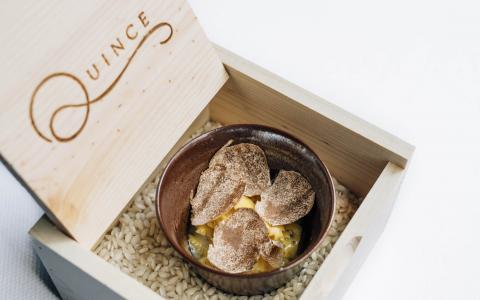
So you’re dining at a fancy restaurant and choose to splurge on some truffles to top off your repast.
The server steps up and presents the vaguely ugly tuber.
As the pungent slices rain down on your main course, the waiter announces that these truffles didn’t come from Italy, the traditional provenance of this decadent garnish.
They hail from Greece.
Don’t be shocked.
Italians have successfully positioned their product as the most luxurious under the forest floor.
But white Alba truffles—tuber magnatum pico—also grow magnificently well in Greece.
Even Aristotle mentions them in his writings, but they never made it into the local cuisine.
Unlike Italy’s truffles, which have been dug up and eaten for centuries, Greece’s truffles have remained largely undisturbed.
At least they did until the Athens-based culinary exporter Eklekto saw their potential for the U.S. market.
But there’s an additional reason to embrace Greek truffles.
Usually, countless middlemen touch an Italian truffle before it makes it to market, increasing the consumer’s chances of getting a counterfeit version.
Eklekto partners Peter Weltman and George Athanas say they work only with a small group of Greek foragers and know exactly where the product is from.
Apart from the forager working with his trusty dog, Weltman and Athanas are the only people that touch the truffles before export, the company says.
Initially, it was mutual interest in Greek wine that brought Weltman and Athanas together, but a mutual friend and respected mycologist pointed them to truffles.
Bitten by the Greek truffle bug, Weltman—a trained chef and sommelier—brought a cache of tubers back with him to San Francisco-area restaurants in 2016, jamming a pile of Greek Burgundy’s into a stinky backpack.
“You bring in caper leaves and it’s one thing,” he says of these sales calls.
“But truffles are a whole other ballgame.”
Everywhere Weltman went, the kitchen staff gathered around to peer into his Tupperware.
They loved the scent: more buttery and saltier than the smokier French version and different from the Perigords—melanosporum—that he had later, which were more fruity, earthy and pungent. Still, they were sent off without a sale
In 2017, Eklekto’s foragers began unearthing the prized white truffle that, in addition to Italy and Greece, also comes from Slovenia and Macedonia. More than a few Italian truffles have a good chance of actually hailing from these countries, given the premium prices they command and the ease of exporting them. At Urbani, which controls 70% of the world’s truffle market, Vittorio Giordano, vice president of the U.S. and Canada division, says he’s paying close attention to his Alba sources.
“As a truffle company, we have to keep an eye on the product,” he says. “If there are other areas producing the same truffle, we definitely have to pay attention.”
Nevertheless, with Alba prices climbing due to drought, the timing for Greek truffles was perfect. Last year, Italian truffles jumped to $3,500 a pound wholesale. Greek truffles were slightly cheaper, going for $3,150 a pound. Equally delicious, but not as rare, Perigords fetched $840 a pound.
The same species as the Alba, Eklekto’s Greek white truffle smells and tastes just as delicious. One convert is chef Michael Tusk at San Francisco’s Quince restaurant.
Tusk is a prodigious user of the luxury ingredient.
“People are paying a lot of money,” Tusk says.
Because of this, sometimes he would take over in the dining room for any cautious captains.
“I was never really fond of conservative shaving. It was either go big or go home.”
During his annual, eight-night, white truffle festival, he uses about two kilograms a day. In peak season, Tusk will spend around $100,000 on truffles.



